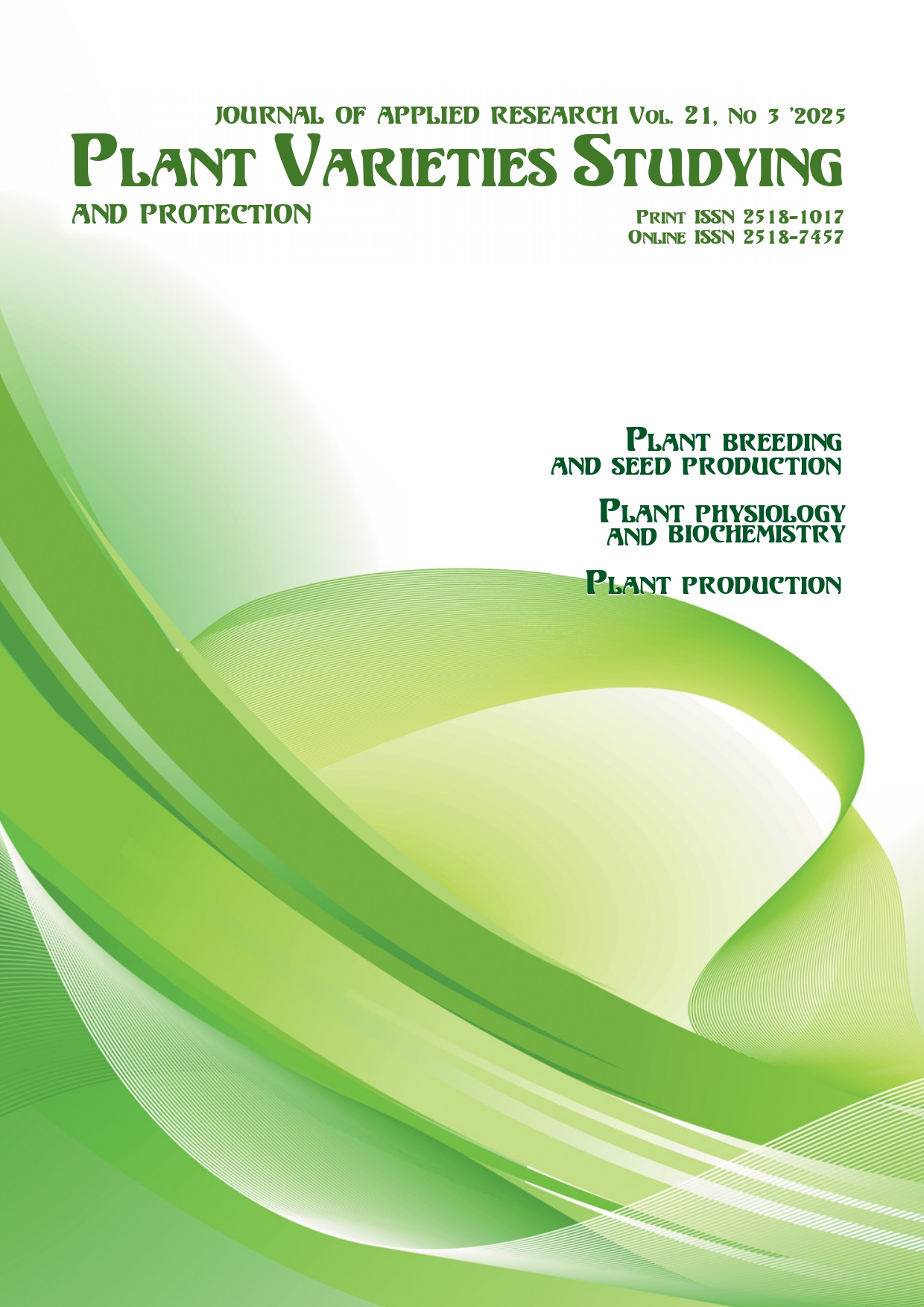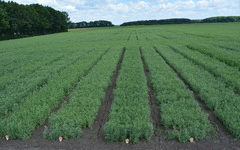Peculiarities of the metabolism of fruit vines Actinidia arguta (Siebold & Zucc.) Planch. ex Miq. and Schizandra chinensis (Turcz.) Baill. in mixed and mono-planting growth
DOI:
https://doi.org/10.21498/2518-1017.21.3.2025.339315Keywords:
allelopathy, biochemical indicators, secondary metabolites, photosynthetic pigmentsAbstract
Purpose. A comparative study of the interaction between A. arguta and S. chinensis plants in mono- and mixed plantings was carried out. This study examined the pigment complex of the plants and the accumulation of flavonols and proline in their vegetative organs. The aim was to optimise the technology for growing these promising fruit plants and realise their productive potential. This research was conducted at the M. M. Gryshko National Botanical Garden of the National Academy of Sciences of Ukraine (Kyiv). Methods. The quantitative content of pigments, flavonols and proline was determined using the spectrophotometric method with a Zalimp KF 77 spectrophotometer (Poland), in accordance with the relevant procedures. Plants that had grown for 40 years in grey forest soil (pH 6.5–7.0) were analysed. Results. Analysis of the experimental data revealed significant differences in flavonol content and accumulation dynamics between the studied species in mono- and mixed plantings during the growing season. Leaves of actinidia in mono-plantings had higher levels of these compounds than plants in mixed plantings. The accumulation of proline in actinidia leaves in combined plantings with magnolia vine was lower throughout the entire research period compared to mono-species plantings. Leaves of magnolia vines in monoculture accumulated 20% less proline than plants growing alongside actinidia. Mixed plantings were found to result in a 1.6-fold higher accumulation of chlorophyll in A. arguta compared to mono-species plantings. Conclusions. A. arguta plants grown alongside S. chinensis plants exhibit improved growth compared to those grown in mono-cultures. S. chinensis is an autotolerant plant for which mono-species plantings are preferable. The proline and flavonoid content of vine leaves, as well as their pigment complex, can serve as an indicator of the plants' physiological state and competitiveness in garden cenoses.
Downloads
References
Moroz, P. A. (1990). Allelopathy in fruit orchards. Naukova Dumka. [In Ukrainian]
Lohbeck, M., Bongers, F., Martinez-Ramos, M., & Poorter, L. (2016). The importance of biodiversity and dominance for multiple ecosystem functions in a human-modified tropical landscape. Ecology, 97(10), 2772–2779. https://doi.org/10.1002/ecy.1499
 |
| 
Jing, L., Zhao, M., Li, P., & Xu, X. (2017). A convolutional neural network based feature learning and fault diagnosis method for the condition monitoring of gearbox. Measurement, 111, 1–10. https://doi.org/10.1016/j.measurement.2017.07.017

Osypova, I. Yu., & Moroz, P. A. (2001). Allelopathic properties of new fruit cultures. Plant Introduction, 1–2, 98–109. https://doi.org/10.5281/zenodo.3334624 [In Ukrainian]
Skrypchenko, N. V., Dziuba, O. I., & Horbenko, N. Ye. (2020). Assessment of soil fatigue under long-term cultivation of woody fruit lianas. Scientific Bulletin of UNFU, 30(3), 36–40. https://doi.org/10.36930/40300306
Dragoeva, A. P., Nanova, Z. D., & Kalcheva, V. P. (2010). Allelopathic activity of micropropagated Hyssopus officinalis L., Lamiaceae, water infusions. Revista Brasileira de Farmacognosia, 20(4), 513–518. https://doi.org/10.1590/S0102-695X2010000400009
Hussain, M. I., Danish, S., Sánchez-Moreiras, A. M., Vicente, Ó., Jabran, K., Chaudhry, U. K., Branca, F., & Reigosa, M. J. (2021). Unraveling sorghum allelopathy in agriculture: Concepts and implications. Plants, 10(9), Article 1791. https://doi.org/10.3390/plants10091795
 |
| 
Wei, Z., Ying, H., Guo, X., Zhuang, M., Cui, Z., & Zhang, F. (2020). Substitution of mineral fertilizer with organic fertilizer in maize systems: A meta-analysis of reduced nitrogen and carbon emissions. Agronomy, 10(8), Article 1149. https://doi.org/10.3390/agronomy10081149

Lazar, T. (2003). Taiz, L. and Zeiger, E. Plant physiology. 3rd edn. Annals of Botany, 91(6), 750–751. https://doi.org/10.1093/aob/mcg079
Pérez-Bueno, M., Pineda, M., & Barón Ayala, M. (2019). Phenotyping plant responses to biotic stress by chlorophyll fluorescence imaging. Frontiers in Plant Science, 10, Article 1135. https://doi.org/10.3389/fpls.2019.01135
 |
| 
Kondratenko, P. V., & Bublyk, M. O. (1996). Methods of conducting field experiments with fruit crops. Agrarna Nauka. [In Ukrainian]
Nurlinda, N., Handayani, V., & Rasyid, F. A. (2021). Spectrophotometric determination of total flavonoid content in Biancaea sappan (Caesalpinia sappan L.) leaves. Jurnal Fitofarmaka Indonesia, 8(3), 1–4. https://doi.org/10.33096/jffi.v8i3.712
Bates, L. S., Waldren, R. P., & Teare, I. D. (1973). Rapid determination of free proline for water-stress studies. Plant and Soil, 39(1), 205–207. https://doi.org/10.1007/BF00018060

Chakchyr, B. A., & Alekseeva, H. M. (2002). Photometric methods of analysis: Methodological guidelines.
Blum, U., Shafer, S. R., & Lehman, M. E. (1999). Evidence for inhibitory allelopathic interactions involving phenolic acids in field soils: Concepts vs. experimental model. Critical Reviews in Plant Sciences, 18(5), 637–693. https://doi.org/10.1080/07352689991309441

Grodzinskiy, A. M. (1981). About the new concept of allelopathy. In Chemical Interaction of Plants (pp. 3–18). Naukova Dumka.
Kochubei, S. M., Shevchenko, V. V., Bondarenko, O. Yu., & Panas, Y. D. (2013). Dynamics of changes in the functional activity of the photosynthetic apparatus of pea plants caused by high-temperature stress. Reports of the National Academy of Sciences of Ukraine, 6, 152–156. [In Ukrainian]
Shadchyna, T. M., Huliaiev, B. I., & Kirizii, D. A. (2006). Regulation of photosynthesis and plant productivity: Physiological and ecological aspects. Fitosotsiotsentr. [In Ukrainian]
Ahmad, P. (2014). Oxidative damage to plants: Antioxidant networks and signaling. Academic Press.
Peter, A. J. (2001). The replacement series. Journal of Ecology, 88(3), 371–385. https://doi.org/10.1046/j.1365-2745.2000.00470.x

Published
How to Cite
Issue
Section
License
Copyright (c) 2025 N. V. Skrypchenko, V. F. Levon, T. B. Venediktova, V. P. Knysh

This work is licensed under a Creative Commons Attribution-ShareAlike 4.0 International License.
Starting in 2022, the copyright to the publication remains with the authors
Our journal abides by the CREATIVE COMMONS copyright rights and permissions for open access journals.
Authors, who are published in this journal, agree to the following conditions:
- The authors reserve the right to authorship of the work and pass the first publication right of this work to the journal under the terms of a Creative Commons Attribution License, which allows others to freely distribute the published research with the obligatory reference to the authors of the original work and the first publication of the work in this journal.
- The authors have the right to conclude separate supplement agreements that relate to non-exclusive work distribution in the form in which it has been published by the journal (for example, to upload the work to the online storage of the journal or publish it as part of a monograph), provided that the reference to the first publication of the work in this journal is included.

























 Ukrainian Institute for Plant Varieties Examination
Ukrainian Institute for Plant Varieties Examination  Селекційно-генетичний інститут
Селекційно-генетичний інститут Institute of Plant Physiology and Genetics of the National Academy of Sciences of Ukraine
Institute of Plant Physiology and Genetics of the National Academy of Sciences of Ukraine
 The National Academy of Agrarian Sciences of Ukraine
The National Academy of Agrarian Sciences of Ukraine